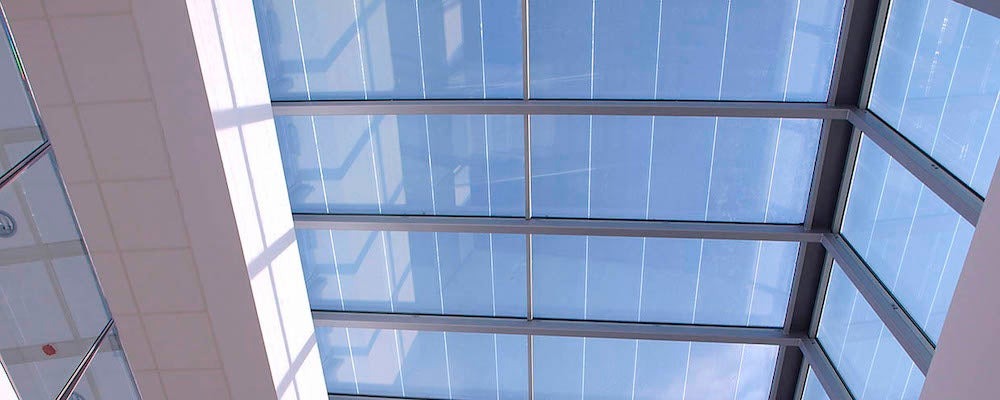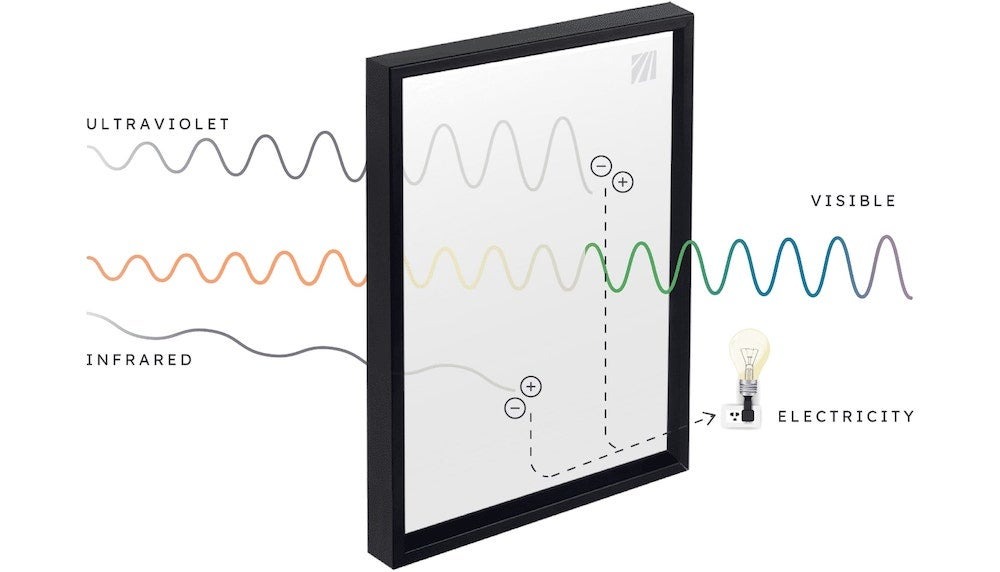Updated 7 months ago
What are solar windows?
Written by Ana Almerini Ana AlmeriniAna is the Marketing & Communications Manager at SolarReviews, working within the solar industry since 2020. With a Master's in Climate and Society an...Learn more


Why you can trust SolarReviews
SolarReviews is the leading American website for solar panel reviews and solar panel installation companies. Our industry experts have a combined three decades of solar experience and maintain editorial independence for their reviews. No company can pay to alter the reviews or review scores shown on our site. Learn more about SolarReviews and how we make money.
Solar windows, sometimes called solar glass windows, act as a window while generating electricity from the sun. The potential for solar windows is enormous. They could be used for entire skyscrapers or to enhance a home’s ability to generate solar power.
Solar windows are one of the newest areas of interest in the building-integrated photovoltaics (BIPV) market. BIPV gets its name because, by design, the photovoltaic component is meant to be incorporated into the building design itself. Think of BIPV as Tesla solar shingles versus Tesla solar panels, which are not part of your roof but added on top of your roof.
Unfortunately, you are not yet able to buy solar windows to install in your home or commercial buildings as a source of renewable energy.
In this article, we will review the different prototypes that are currently being tested, how they work, and what advantages they have over traditional photovoltaic (PV) panels.
Key takeaways
Unlike traditional solar panels, solar windows can filter UV and infrared sunlight and use it to generate electricity.
Ubiquitous Energy and Physee are two companies vying to make their solar window technology commercially available.
Solar windows can be added to entire skyscrapers or as an addition to your home’s solar panel system.
How do solar windows work?
There are a few different ways that solar windows can work. What makes solar windows different from traditional solar panels is the fact that they are meant to absorb all kinds of light rays, including ultraviolet rays (UV), that PV panels cannot absorb.
Because solar windows would be able to absorb UV light, they could line an entire building from floor to ceiling at angles that traditional solar panels would not succeed in capturing sunlight. Solar windows can work in a few ways, through quantum dots semiconducting material that absorbs the sun's energy or from a luminescent solar concentrator, such as from luminescent particles in food.
Essentially, these two methods absorb different wavelengths of light and move the light in the panel to a solar cell where it can then be turned into energy.
Solar windows are a generally new technology, only being tested within the last 10 years or so. Because they are relatively new, they are not yet available at scale. But there are a few companies that are working on creating solar windows that can be used for most building types.
What companies produce solar windows, can you buy them?

Ubiquitous Energy’s technology filters UV and infrared light to generate electricity. Image source: Ubiquitous Energy
There are a few companies that are researching and building solar windows including Ubiquitous Energy and Physee Power.
Ubiquitous Energy's research began at MIT and Michigan State University in 2010, eventually moving to Redwood City, California to further develop their product. This led to the invention of a transparent solar cell coating, or type quantum dot semiconductor, that can be integrated into standard windows.
The goal is to have a coating that can be applied to existing windows, which would reduce installation time. The coating then absorbs UV and infrared light, using this energy to generate electricity. In 2016, their first window prototype was produced and is now being tested during the first installation of their transparent solar windows.
In the Netherlands, Physee is working on developing their Power+ window coating technology. Similar to Ubiquitous Energy, Physee is working on a coating that can generate energy from UV and infrared light that is currently underutilized while it passes through windows. Their first prototype installation, PowerWindow, was added to a Dutch Bank in 2017.
Both companies are aiming to maintain the transparency of glass to allow for visible light to pass through while making windows a new source of power. As of right now, you cannot buy either company's semi-transparent coating to add to your home's windows. While these remain in the prototype phase, the potential future impact is very exciting.
What other solar windows are being explored?
Solar windows are a busy area of research with specialists ranging from the National Renewable Energy Laboratory (NREL) to universities and students. Researchers are studying the ability to use food waste to absorb UV light to perovskite solar cells. These emerging technologies are different from a coating that can be applied to windows because they are built into the glass itself.
AuREUS, the new research startup, utilizes luminescent particles from food waste to create a panel that absorbs UV light, or a type of luminescent solar concentrator. These panels are also still in the research phase but they have the potential to help eliminate food waste and generate electricity from UV light.
While still being researched, perovskite solar cells are close to being commercially available. What sets perovskite materials apart from traditional photovoltaic cells is the fact that they can be used in tandem with another absorber material, such as crystalline silicon, to create even more energy than either material can generate alone.
The hope is that once perovskite cells are developed in a way that is commercially viable, they can be incorporated into other materials such as glass. But for now, both perovskite and AeREUS are keeping researchers busy working towards a breakthrough.
Why pick solar windows over a traditional solar roof?
Solar windows will have an advantage over conventional solar panels because they can be installed where windows typically go; on the side of buildings. This distinction is important because they can absorb the UV light or infrared light that bounces off surfaces and hits the windows from all directions. This means solar windows do not need to be angled towards the sun to catch the energy-giving rays.
This will revolutionize solar energy as an entire building, from roof to windows, can be working daily to capture all of the light that hits it. Currently, UV and infrared light are not absorbed by PV panels, although perovskite cells might give them this ability in the future.
Generally, solar windows will make the most sense for skyscrapers or larger buildings or as an addition to your home solar panels. Because solar window technology will most likely be less energy-efficient than solar panels, generating electricity from about 10% of sunlight vs. a solar panel's 20%, they might not be efficient enough to power your entire home.
The future of solar windows
Solar windows offer so much potential, they can allow entire buildings to be power-generating entities. It will be exciting to see where the prototypes and research will lead in the coming years and if we will ever be able to produce solar window panes or solar window coating on a large scale.
For now, traditional PV rooftop solar panels are your best option for utilizing solar energy. To take advantage of the sunlight and save money on your electricity bills, contact a local installer to find out the cost of going solar in your area. Until solar windows are available for purchase, adding solar panels to your roof makes more sense for homeowners interested in clean energy.
Ana is the Marketing & Communications Manager at SolarReviews, working within the solar industry since 2020. With a Master's in Climate and Society and professional experience in marketing, she helps communicate the value of solar to homeowners and build awareness of the SolarReviews brand. On weekends you can find her at the Jersey shore, reading a book from the ever-increasing stack on her side table, or eating food someone else cooked....
Learn more about Ana Almerini